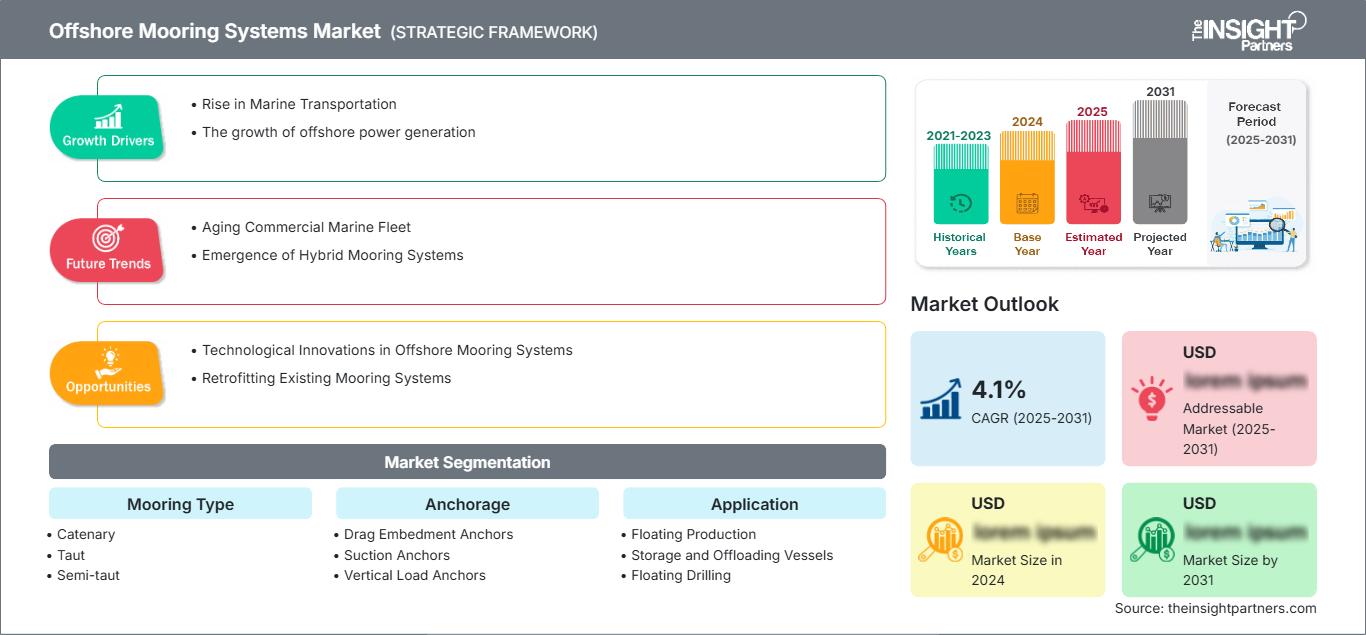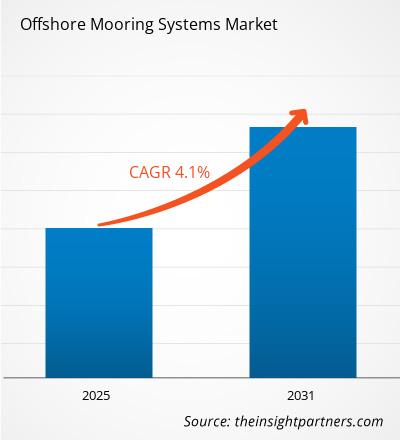Le marché des systèmes d'amarrage offshore devrait enregistrer un TCAC de 4,1 % entre 2025 et 2031, avec une taille de marché passant de XX millions de dollars américains en 2024 à XX millions de dollars américains d'ici 2031.
Le rapport est segmenté par type d'amarrage (caténaire, tendu, semi-tendu, étalé, point unique et positionnement dynamique), ancrage (ancres d'encastrement par traînée, ancres à succion et ancres à charge verticale), application (navires flottants de production, de stockage et de déchargement (FPSO), navires flottants de forage, de production, de stockage et de déchargement (FDPSO), navires flottants de gaz naturel liquéfié (FLNG), plateformes à jambes de force, semi-submersibles, plateformes Spar et autres). L'analyse mondiale est ensuite ventilée au niveau régional et par principaux pays. Le rapport offre la valeur en USD pour l'analyse et les segments ci-dessus.
Objectif du rapport
Le rapport sur le marché des systèmes d'amarrage offshore de The Insight Partners vise à décrire le paysage actuel et la croissance future, les principaux facteurs moteurs, les défis et les opportunités. Cela fournira des informations à diverses parties prenantes commerciales, telles que :
- Fournisseurs/fabricants de technologies : pour comprendre l'évolution de la dynamique du marché et connaître les opportunités de croissance potentielles, leur permettant de prendre des décisions stratégiques éclairées.
- Investisseurs : pour réaliser une analyse complète des tendances concernant le taux de croissance du marché, les projections financières du marché et les opportunités qui existent tout au long de la chaîne de valeur.
- Organismes de réglementation : pour réglementer les politiques et les activités de police sur le marché afin de minimiser les abus, de préserver la confiance des investisseurs et de maintenir l'intégrité et la stabilité du marché.
Segmentation du marché des systèmes d'amarrage offshore Type d'amarrage
- Caténaire
- Tendu
- Semi-tendu
- Étendu
- Point unique
- Positionnement dynamique
Ancrage
- Ancres à ancrage par traînée
- Ancres à succion
- Ancres à charge verticale
Application
- Navires flottants de production
- de stockage et de déchargement
- Navires flottants de forage
- de production
- de stockage et de déchargement
- Navires flottants de gaz naturel liquéfié
- Plateformes à jambes de force
- Semi-submersibles
- Plateformes Spar
Géographie
- Amérique du Nord
- Europe
- Asie-Pacifique
- Amérique du Sud et centrale
- Moyen-Orient et Afrique
Vous bénéficierez d’une personnalisation sur n’importe quel rapport - gratuitement - y compris des parties de ce rapport, ou une analyse au niveau du pays, un pack de données Excel, ainsi que de profiter d’offres exceptionnelles et de réductions pour les start-ups et les universités
Marché des systèmes d'amarrage offshore: Perspectives stratégiques

- Obtenez les principales tendances clés du marché de ce rapport.Cet échantillon GRATUIT comprendra une analyse de données, allant des tendances du marché aux estimations et prévisions.
Facteurs de croissance du marché des systèmes d'amarrage offshore
- Augmentation du transport maritime : Le transport maritime a gagné en popularité ces dernières années, car il offre des tarifs plus avantageux, est idéal pour les marchandises volumineuses et permet une connexion facile avec d'autres régions du monde. L'un des principaux avantages du transport maritime est la capacité des compagnies maritimes à expédier des chargements lourds et surdimensionnés, communément appelés « breakbulk » ou « charges non remorquées » (NIT). Les gros véhicules, équipements, matériaux de construction et autres articles peuvent être transportés en tant que fret. Français Par conséquent, l'essor du transport maritime devrait stimuler le marché des systèmes d'amarrage offshore dans les années à venir.
- La croissance de la production d'énergie offshore : L'augmentation des investissements dans les projets d'énergie éolienne offshore, la production pétrolière et gazière offshore et les projets d'énergie océanique devrait stimuler la demande de navires, ce qui devrait à son tour stimuler la croissance du marché des systèmes d'amarrage offshore dans les années à venir.
Tendances futures du marché des systèmes d'amarrage offshore
- Vieillissement de la flotte maritime commerciale : Dans presque tous les pays, la majorité de la flotte de navires commerciaux est âgée. Selon les données publiées par les Nations Unies en 2023, l'âge moyen des navires dans le monde était de 22,2 ans, et plus de la moitié des navires ont plus de 15 ans. De plus, selon les données fournies par le Bureau of Transportation des États-Unis en 2021, il y avait environ 27 000 navires aux États-Unis qui avaient plus de 15 ans. Par conséquent, le besoin de remplacement de la flotte commerciale augmentera, ce qui devrait créer des opportunités de croissance positives pour la croissance du marché des systèmes d'amarrage offshore au cours de la période de prévision.
- Émergence des systèmes d'amarrage hybrides : L'émergence de systèmes d'amarrage hybrides qui combinent des méthodes d'amarrage traditionnelles avec des technologies de positionnement dynamique gagne du terrain. Cette tendance améliore la flexibilité opérationnelle et l'adaptabilité aux conditions environnementales variables.
Opportunités de marché des systèmes d'amarrage offshore
- Innovations technologiques dans les systèmes d'amarrage offshore : Au fil des décennies, les progrès technologiques ont conduit à des améliorations significatives des systèmes d'amarrage. L'accent était mis sur l'augmentation de l'efficacité, la réduction de la taille et l'amélioration de la fiabilité de ces systèmes. Ce changement a permis une plus grande flexibilité et une plus grande efficacité dans la production d'électricité pour répondre aux différentes exigences de charge électrique à bord des navires. Par conséquent, les innovations technologiques devraient être la tendance clé du marché.
- Rénovation des systèmes d'amarrage existants : Le potentiel de modernisation des systèmes d'amarrage offshore existants avec des technologies de pointe offre des opportunités importantes. Les entreprises peuvent cibler les opérateurs qui cherchent à améliorer les performances et la sécurité de leurs solutions d’amarrage actuelles.
Aperçu régional du marché des systèmes d'amarrage offshore
Les tendances régionales et les facteurs influençant le marché des systèmes d'amarrage offshore tout au long de la période de prévision ont été analysés en détail par les analystes de The Insight Partners. Cette section aborde également les segments et la géographie du marché des systèmes d'amarrage offshore en Amérique du Nord, en Europe, en Asie-Pacifique, au Moyen-Orient et en Afrique, ainsi qu'en Amérique du Sud et en Amérique centrale.
Portée du rapport sur le marché des systèmes d'amarrage offshore
| Attribut de rapport | Détails |
|---|---|
| Taille du marché en 2024 | US$ XX million |
| Taille du marché par 2031 | US$ XX Million |
| TCAC mondial (2025 - 2031) | 4.1% |
| Données historiques | 2021-2023 |
| Période de prévision | 2025-2031 |
| Segments couverts |
By Type d'amarrage
|
| Régions et pays couverts | Amérique du Nord
|
| Leaders du marché et profils d'entreprises clés |
|
Densité des acteurs du marché des systèmes d'amarrage offshore : comprendre son impact sur la dynamique des entreprises
Le marché des systèmes d'amarrage offshore connaît une croissance rapide, portée par une demande croissante des utilisateurs finaux, due à des facteurs tels que l'évolution des préférences des consommateurs, les avancées technologiques et une meilleure connaissance des avantages du produit. Face à cette demande croissante, les entreprises élargissent leur offre, innovent pour répondre aux besoins des consommateurs et capitalisent sur les nouvelles tendances, ce qui alimente la croissance du marché.

- Obtenez le Marché des systèmes d'amarrage offshore Aperçu des principaux acteurs clés
- Analyse historique (2 ans), année de base, prévision (7 ans) avec TCAC
- Analyse PEST et SWOT
- Taille du marché Valeur / Volume - Mondial, Régional, Pays
- Industrie et paysage concurrentiel
- Ensemble de données Excel
Rapports récents
Témoignages
Raison d'acheter
- Prise de décision éclairée
- Compréhension de la dynamique du marché
- Analyse concurrentielle
- Connaissances clients
- Prévisions de marché
- Atténuation des risques
- Planification stratégique
- Justification des investissements
- Identification des marchés émergents
- Amélioration des stratégies marketing
- Amélioration de l'efficacité opérationnelle
- Alignement sur les tendances réglementaires






















 Obtenez un échantillon gratuit pour - Marché des systèmes d'amarrage offshore
Obtenez un échantillon gratuit pour - Marché des systèmes d'amarrage offshore